专题7 动词和动词短语课件(共25张PPT) 2025年中考英语语法专题复习
文档属性
| 名称 | 专题7 动词和动词短语课件(共25张PPT) 2025年中考英语语法专题复习 |  | |
| 格式 | pptx | ||
| 文件大小 | 1.3MB | ||
| 资源类型 | 教案 | ||
| 版本资源 | 人教新目标(Go for it)版 | ||
| 科目 | 英语 | ||
| 更新时间 | 2024-12-03 21:56:04 | ||
图片预览

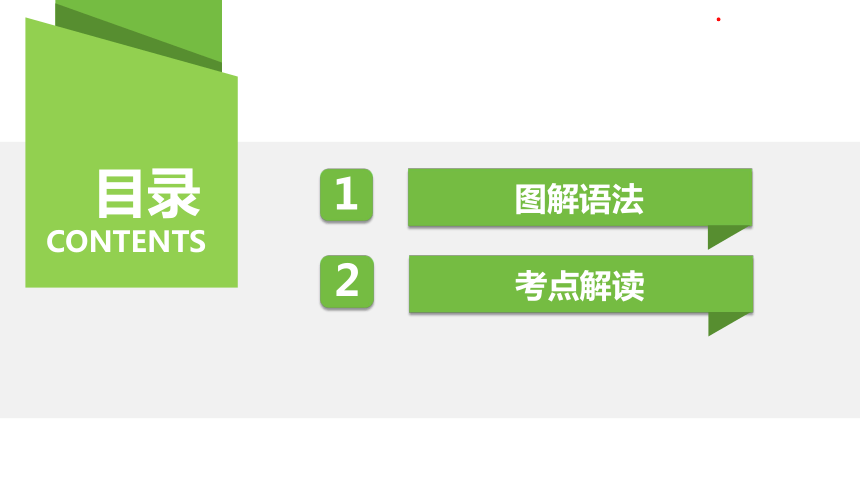

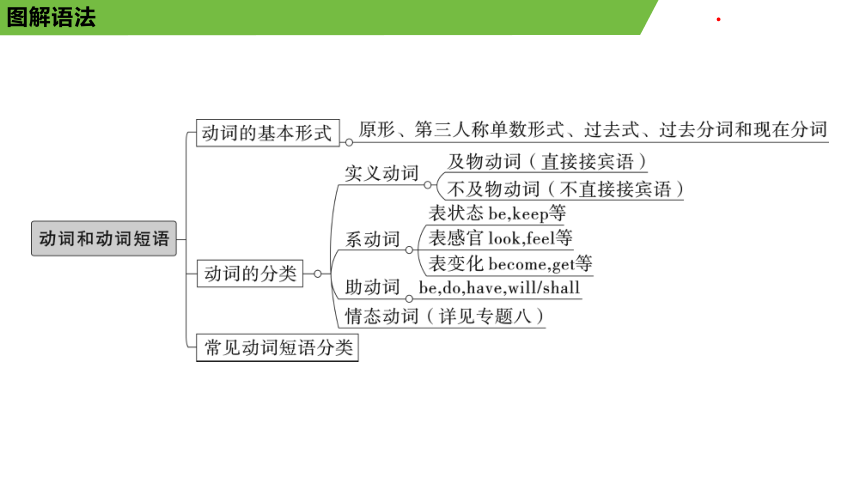

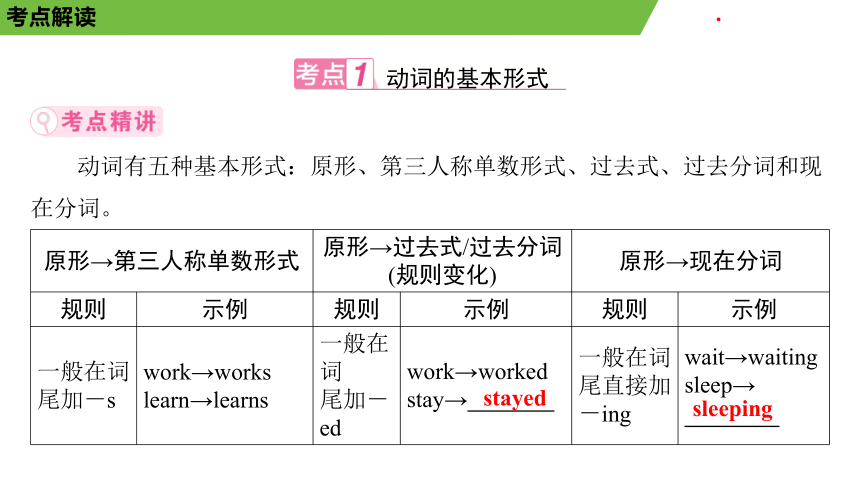
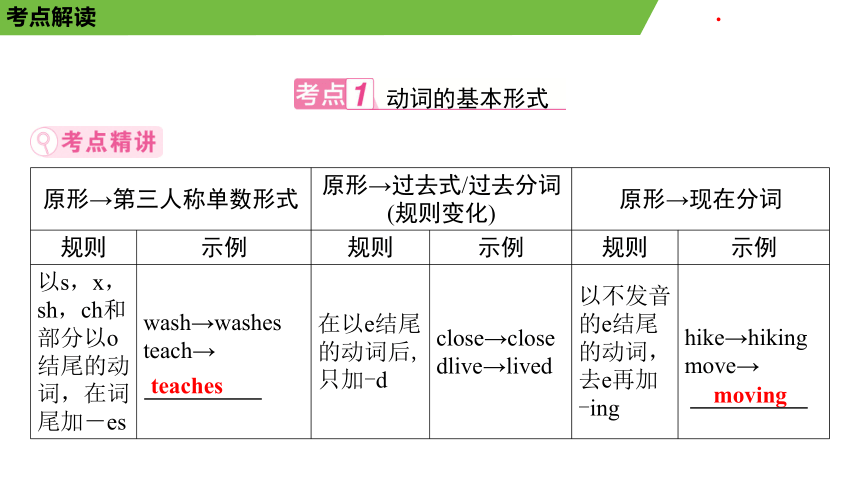

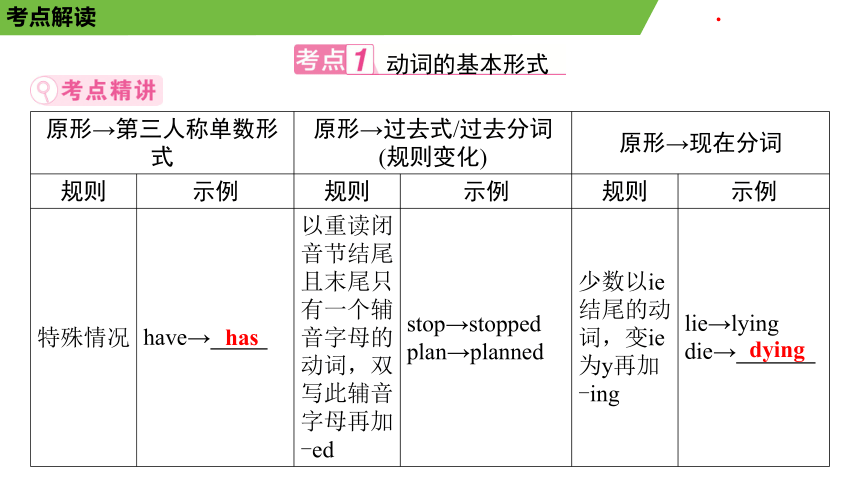
文档简介
(共25张PPT)
专题七 动词和动词短语
目录
CONTENTS
图解语法
1
考点解读
2
图解语法
01
专题七
考点解读
02
专题七
动词有五种基本形式:原形、第三人称单数形式、过去式、过去分词和现
在分词。
动词的基本形式
原形→第三人称单数形式 原形→过去式/过去分词
(规则变化) 原形→现在分词 规则 示例 规则 示例 规则 示例
一般在词
尾加-s work→works learn→learns 一般在词
尾加-ed work→worked stay→
一般在词
尾直接加
-ing wait→waiting
sleep→
stayed
sleeping
原形→第三人称单数形式 原形→过去式/过去分词
(规则变化) 原形→现在分词 规则 示例 规则 示例 规则 示例
以s,x,
sh,ch和
部分以o
结尾的动
词,在词
尾加-es wash→washes teach→
在以e结尾的动词后,只加-d close→closedlive→lived 以不发音
的e结尾
的动词,
去e再加
-ing hike→hiking
move→
teaches
moving
动词的基本形式
原形→第三人称单数形式 原形→过去式/过去分词
(规则变化) 原形→现在分词 规则 示例 规则 示例 规则 示例
以辅音字
母加y结
尾的动
词,变y
为i再加
-es fly→flies study→studies 以辅音字母加y结尾的动词,变y为i再加-ed study→studied worry→worried 以重读闭
音节结尾
且末尾只
有一个辅
音字母的
动词,双
写此辅音
字母再加
-ing sit→sitting
cut→cutting
swim→
swimming
动词的基本形式
原形→第三人称单数形式 原形→过去式/过去分词
(规则变化) 原形→现在分词 规则 示例 规则 示例 规则 示例
特殊情况 have→
以重读闭
音节结尾
且末尾只
有一个辅
音字母的
动词,双
写此辅音
字母再加
-ed stop→stopped plan→planned 少数以ie
结尾的动
词,变ie
为y再加
-ing lie→lying
die→
has
dying
动词的基本形式
1. My sister Tina often (collect) litter with some volunteers in the park.
2. (2024天津改编)Lao She (write) many plays and he was named “the
People’s Artist”.
3. (2024河北)Alex has (study) tea culture since he came to China in
2010.
collects
wrote
studied
动词的基本形式
4. (2024无锡)This stone bridge was (build) over 800 years ago.
5. Lin Tao (brush) his teeth and then has breakfast before going to
school.
6. Tom always does some housework.Now he is (fold) the clothes.
built
brushes
folding
实义动词是表示动作或状态的词,可在句中独立作谓语。根据能否直接接
宾语,可将其分为及物动词(vt.)和不及物动词(vi.)。
1. 及物动词
及物动词本身意义不完整,需要接宾语才能完整表达意思。
如:Lisa usually a at 9 p.m.莉萨通常晚上九点洗淋浴。
实义动词
2. 不及物动词
①不及物动词可单独使用,构成“主语+谓语”结构。
如:At last,Sandy came.最终,桑迪来了。
②不及物动词可与介词、副词等搭配使用。
如:At last,Sandy came to the party.最终,桑迪来参加聚会了。
实义动词
Baduanjin
is a simple health exercise.
It 1 eight gentle steps.
It is good for the old,and it is also fit for young people who 2 for long hours in the office.Besides,it doesn’t 3 . much space or time for the practice.It uses breathing and concentration(专注) skills to 4 both the body and the mind.
实义动词
1. A. has B. teaches C. sells
2. A. sit B. sleep C. walk
3. A. show B. refuse C. need
4. A. guide B. check C. improve
√
√
√
√
5. Boys and girls,good luck and wish you
to get good grades on your new journey!
(英译汉)
孩子们,祝你们好运,希望你们在新的
征程上取得好成绩!
系动词用于连接主语和表语。系动词本身有含义,但不能单独作谓语,后
面必须和表语一起构成“系表”结构,说明主语的身份、性质或状态。
系动词
类别 例词 例句
表状态 be,keep,stay,remain,
seem,appear The sky is blue.天很蓝。
Keep quiet,class.保持安静,同学们。
The little boy seems unhappy.这个小男
孩好像不高兴。
表感官 look,feel,smell,sound,
taste The dish tastes delicious.这道菜尝起来很美味。
表变化 become,get,go,grow,
turn,fall The milk went sour.牛奶变质了。
The days grow longer in summer.夏天白天变得更长。
系动词
【注意】1.系动词没有被动语态形式;
2. 表示状态的系动词不用于进行时态。
noise taste look keep
1. John doesn’t happy today because he failed his test.
2. Peter,the music sounds too .Please turn it down.
3. To healthy,students in our school do morning exercises every day.
4. The Dongjiang Fish in Hunan delicious.Try it after you get
there.
5. In autumn,leaves turn yellow and fall off the trees.(英译汉)
look
noisy
keep
tastes
秋天树叶变黄,从树上掉落下来。
系动词
助动词本身无意义或意义不完全,不能单独作谓语。助动词在句中和实义
动词或系动词一起构成谓语,表示时态、语态、人称和数。
助动词
助动词 用法 例句
be 构成现在进行时(am/is/are+
现在分词) Jenny is teaching English.珍妮正在教
英语。
构成过去进行时(was/were+
现在分词) I was reading books when my mom
came back.我妈妈回来的时候,我正
在读书。
构成一般将来时和过去将来
时 (am/is/are/was/were) going to We are going to have a study trip
tomorrow.我们明天要去研学旅行。
构成被动语态(be+过去分词) A lot of birds are protected in nature
parks.许多鸟在自然公园受到保护。
助动词
助动词 用法 例句
do 构成疑问句和否定句 Do you like music?你喜欢音乐吗?
Tom doesn’t like eating candies.汤姆
不喜欢吃糖果。
代替上文出现过的动词 I don’t like playing soccer,but my
sister does.我不喜欢踢足球,但我妹
妹喜欢。
构成否定祈使句 Don’t be noisy!不要喧哗!
助动词
助动词 用法 例句
have 构成现在完成时(have/has+
过去分词) I have been a doctor for three years.我
成为一名医生已经三年了。
构成过去完成时(had+过去分词) The bus had left when I arrived.我赶到
的时候公共汽车已经走了。
will/shall 构成一般将来时(will/shall+动词原形) There will be more trees in the future.
将来会有更多的树。
助动词
1. Sorry,I can’t hear you.The wind is (blow) hard.Can you speak
louder?
2. Jenny,you have (change) a lot,much thinner and more hard-
working than before.
blowing
changed
助动词
3. (2024连云港改编)Robot dogs were (use)
as volunteers for the first time during the 19th Asian Games.
4. (2024白银改编)Don’t let the Internet take up most of your time!(英译汉)
used
不要让网络占据你大部分的时间!
助动词
5. (2024东营改编)没有人知道明天将会发生什么。(汉译英)
Nobody knows tomorrow.
what
will
happen
动词短语是指动词跟介词或副词等构成的固定短语。常见分类有:
1. 动词+介词
宾语只能位于介词后面。如:look after,care about,go through等。
2. 动词+副词
若宾语为代词则需位于动词和副词之间。如:turn it on,turn on the blender,
turn the blender on等。
常见动词短语分类
3. 动词+副词+介词
宾语只能位于介词后面。如:get along with,look forward to,come up
with等。
4. 动词+名词+介词
名词前可加形容词来修饰,宾语只能位于介词后面。如:take pride in,take
(good) care of等。
★更多常见动词短语见《词汇册》P59
常见动词短语分类
1. (2023岳阳改编)The teacher tells students to look new words in a
dictionary.
2. (2024扬州改编)My little brother is very creative,and he can always come
up new ideas.
3. The old man is kind.He always gives books to the children in poor
areas.
4. When we meet problems,we should face them bravely and never give
up.(英译汉)
up
with
away
当我们遇到难题时,我们应该勇敢面对,永不放弃。
常见动词短语分类
5. 我妈妈总是把我们一家人都照顾得很好。(汉译英)
My mother/mom always looks after our family very well/takes good care of our
family.
专题七 动词和动词短语
目录
CONTENTS
图解语法
1
考点解读
2
图解语法
01
专题七
考点解读
02
专题七
动词有五种基本形式:原形、第三人称单数形式、过去式、过去分词和现
在分词。
动词的基本形式
原形→第三人称单数形式 原形→过去式/过去分词
(规则变化) 原形→现在分词 规则 示例 规则 示例 规则 示例
一般在词
尾加-s work→works learn→learns 一般在词
尾加-ed work→worked stay→
一般在词
尾直接加
-ing wait→waiting
sleep→
stayed
sleeping
原形→第三人称单数形式 原形→过去式/过去分词
(规则变化) 原形→现在分词 规则 示例 规则 示例 规则 示例
以s,x,
sh,ch和
部分以o
结尾的动
词,在词
尾加-es wash→washes teach→
在以e结尾的动词后,只加-d close→closedlive→lived 以不发音
的e结尾
的动词,
去e再加
-ing hike→hiking
move→
teaches
moving
动词的基本形式
原形→第三人称单数形式 原形→过去式/过去分词
(规则变化) 原形→现在分词 规则 示例 规则 示例 规则 示例
以辅音字
母加y结
尾的动
词,变y
为i再加
-es fly→flies study→studies 以辅音字母加y结尾的动词,变y为i再加-ed study→studied worry→worried 以重读闭
音节结尾
且末尾只
有一个辅
音字母的
动词,双
写此辅音
字母再加
-ing sit→sitting
cut→cutting
swim→
swimming
动词的基本形式
原形→第三人称单数形式 原形→过去式/过去分词
(规则变化) 原形→现在分词 规则 示例 规则 示例 规则 示例
特殊情况 have→
以重读闭
音节结尾
且末尾只
有一个辅
音字母的
动词,双
写此辅音
字母再加
-ed stop→stopped plan→planned 少数以ie
结尾的动
词,变ie
为y再加
-ing lie→lying
die→
has
dying
动词的基本形式
1. My sister Tina often (collect) litter with some volunteers in the park.
2. (2024天津改编)Lao She (write) many plays and he was named “the
People’s Artist”.
3. (2024河北)Alex has (study) tea culture since he came to China in
2010.
collects
wrote
studied
动词的基本形式
4. (2024无锡)This stone bridge was (build) over 800 years ago.
5. Lin Tao (brush) his teeth and then has breakfast before going to
school.
6. Tom always does some housework.Now he is (fold) the clothes.
built
brushes
folding
实义动词是表示动作或状态的词,可在句中独立作谓语。根据能否直接接
宾语,可将其分为及物动词(vt.)和不及物动词(vi.)。
1. 及物动词
及物动词本身意义不完整,需要接宾语才能完整表达意思。
如:Lisa usually a at 9 p.m.莉萨通常晚上九点洗淋浴。
实义动词
2. 不及物动词
①不及物动词可单独使用,构成“主语+谓语”结构。
如:At last,Sandy came.最终,桑迪来了。
②不及物动词可与介词、副词等搭配使用。
如:At last,Sandy came to the party.最终,桑迪来参加聚会了。
实义动词
Baduanjin
is a simple health exercise.
It 1 eight gentle steps.
It is good for the old,and it is also fit for young people who 2 for long hours in the office.Besides,it doesn’t 3 . much space or time for the practice.It uses breathing and concentration(专注) skills to 4 both the body and the mind.
实义动词
1. A. has B. teaches C. sells
2. A. sit B. sleep C. walk
3. A. show B. refuse C. need
4. A. guide B. check C. improve
√
√
√
√
5. Boys and girls,good luck and wish you
to get good grades on your new journey!
(英译汉)
孩子们,祝你们好运,希望你们在新的
征程上取得好成绩!
系动词用于连接主语和表语。系动词本身有含义,但不能单独作谓语,后
面必须和表语一起构成“系表”结构,说明主语的身份、性质或状态。
系动词
类别 例词 例句
表状态 be,keep,stay,remain,
seem,appear The sky is blue.天很蓝。
Keep quiet,class.保持安静,同学们。
The little boy seems unhappy.这个小男
孩好像不高兴。
表感官 look,feel,smell,sound,
taste The dish tastes delicious.这道菜尝起来很美味。
表变化 become,get,go,grow,
turn,fall The milk went sour.牛奶变质了。
The days grow longer in summer.夏天白天变得更长。
系动词
【注意】1.系动词没有被动语态形式;
2. 表示状态的系动词不用于进行时态。
noise taste look keep
1. John doesn’t happy today because he failed his test.
2. Peter,the music sounds too .Please turn it down.
3. To healthy,students in our school do morning exercises every day.
4. The Dongjiang Fish in Hunan delicious.Try it after you get
there.
5. In autumn,leaves turn yellow and fall off the trees.(英译汉)
look
noisy
keep
tastes
秋天树叶变黄,从树上掉落下来。
系动词
助动词本身无意义或意义不完全,不能单独作谓语。助动词在句中和实义
动词或系动词一起构成谓语,表示时态、语态、人称和数。
助动词
助动词 用法 例句
be 构成现在进行时(am/is/are+
现在分词) Jenny is teaching English.珍妮正在教
英语。
构成过去进行时(was/were+
现在分词) I was reading books when my mom
came back.我妈妈回来的时候,我正
在读书。
构成一般将来时和过去将来
时 (am/is/are/was/were) going to We are going to have a study trip
tomorrow.我们明天要去研学旅行。
构成被动语态(be+过去分词) A lot of birds are protected in nature
parks.许多鸟在自然公园受到保护。
助动词
助动词 用法 例句
do 构成疑问句和否定句 Do you like music?你喜欢音乐吗?
Tom doesn’t like eating candies.汤姆
不喜欢吃糖果。
代替上文出现过的动词 I don’t like playing soccer,but my
sister does.我不喜欢踢足球,但我妹
妹喜欢。
构成否定祈使句 Don’t be noisy!不要喧哗!
助动词
助动词 用法 例句
have 构成现在完成时(have/has+
过去分词) I have been a doctor for three years.我
成为一名医生已经三年了。
构成过去完成时(had+过去分词) The bus had left when I arrived.我赶到
的时候公共汽车已经走了。
will/shall 构成一般将来时(will/shall+动词原形) There will be more trees in the future.
将来会有更多的树。
助动词
1. Sorry,I can’t hear you.The wind is (blow) hard.Can you speak
louder?
2. Jenny,you have (change) a lot,much thinner and more hard-
working than before.
blowing
changed
助动词
3. (2024连云港改编)Robot dogs were (use)
as volunteers for the first time during the 19th Asian Games.
4. (2024白银改编)Don’t let the Internet take up most of your time!(英译汉)
used
不要让网络占据你大部分的时间!
助动词
5. (2024东营改编)没有人知道明天将会发生什么。(汉译英)
Nobody knows tomorrow.
what
will
happen
动词短语是指动词跟介词或副词等构成的固定短语。常见分类有:
1. 动词+介词
宾语只能位于介词后面。如:look after,care about,go through等。
2. 动词+副词
若宾语为代词则需位于动词和副词之间。如:turn it on,turn on the blender,
turn the blender on等。
常见动词短语分类
3. 动词+副词+介词
宾语只能位于介词后面。如:get along with,look forward to,come up
with等。
4. 动词+名词+介词
名词前可加形容词来修饰,宾语只能位于介词后面。如:take pride in,take
(good) care of等。
★更多常见动词短语见《词汇册》P59
常见动词短语分类
1. (2023岳阳改编)The teacher tells students to look new words in a
dictionary.
2. (2024扬州改编)My little brother is very creative,and he can always come
up new ideas.
3. The old man is kind.He always gives books to the children in poor
areas.
4. When we meet problems,we should face them bravely and never give
up.(英译汉)
up
with
away
当我们遇到难题时,我们应该勇敢面对,永不放弃。
常见动词短语分类
5. 我妈妈总是把我们一家人都照顾得很好。(汉译英)
My mother/mom always looks after our family very well/takes good care of our
family.
同课章节目录
- 词法
- 名词
- 动词和动词短语
- 动词语态
- 动词时态
- 助动词和情态动词
- 非谓语动词
- 冠词
- 代词
- 数词和量词
- 形容词副词及其比较等级
- 介词和介词短语
- 连词和感叹词
- 构词法
- 相似、相近词比较
- 句法
- 陈述句
- 一般疑问句和否定疑问句
- 特殊疑问句及选择疑问句
- 反意疑问句
- 存在句(There be句型)
- 宾语从句
- 定语从句
- 状语从句
- 主谓一致问题
- 简单句
- 并列句
- 复合句
- 主谓一致
- 主、表语从句
- 名词性从句
- 直接引语和间接引语
- 虚拟语气
- 感叹句
- 强调句
- 倒装句
- 祈使句
- 句子的成分
- 句子的分类
- 题型专区
- 单项选择部分
- 易错题
- 完形填空
- 阅读理解
- 词汇练习
- 听说训练
- 句型转换
- 补全对话
- 短文改错
- 翻译
- 书面表达
- 任务型阅读
- 语法填空
- 其他资料
